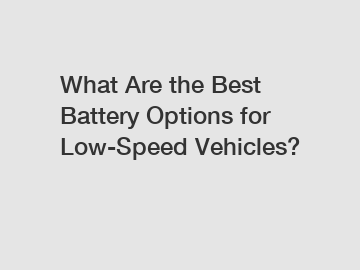What Are the Best Battery Options for Low-Speed Vehicles?
With the rise in environmental consciousness and the growing emphasis on sustainable transportation, low-speed vehicles (LSVs) are gaining popularity as an eco-friendly alternative to traditional cars. These compact vehicles, commonly used for short-distance commutes or within gated communities, offer a cost-effective and energy-efficient solution for urban mobility. One critical aspect that determines the performance and reliability of LSVs is the choice of battery. In this article, we will explore the best battery options available for low-speed vehicles, considering factors such as longevity, power capacity, environmental impact, and overall efficiency.
1. Lithium-Ion Batteries: Unparalleled Performance and Efficiency.
Lithium-ion batteries have become the industry standard for LSVs, thanks to their exceptional energy density and longevity. With their higher voltage and longer cycle life, these batteries ensure a longer range and extended service life for your low-speed vehicle. Furthermore, their ability to withstand frequent charge and discharge cycles makes them ideal for daily use. Lithium-ion batteries are also relatively lightweight and compact, which aids in optimizing the limited space available in LSVs. While they may be slightly more expensive upfront, the long-term benefits and performance make them an excellent investment.

2. Lead-Acid Batteries: Affordable but Limited.
Lead-acid batteries have been traditionally used in LSVs due to their low cost and widespread availability. However, they suffer from drawbacks such as limited cycle life, heavy weight, and slow charging times. The energy density of lead-acid batteries is significantly lower than lithium-ion ones, resulting in restricted mileage and reduced efficiency. These batteries also require regular maintenance, including water refilling and proper ventilation to prevent hydrogen gas buildup. While suited for certain budget-friendly applications, they are not the best option for long-term resilience and performance in LSVs.
3. Nickel-Based Batteries: A Balance of Performance and Affordability.
Nickel-based batteries, such as nickel-cadmium (NiCd) and nickel-metal hydride (NiMH), offer a middle ground between lithium-ion and lead-acid batteries. They provide better energy density and longevity than lead-acid batteries while remaining more affordable than lithium-ion options. Although nickel-based batteries have a reduced risk of thermal runaway compared to lithium-ion, they can still suffer from memory effect and self-discharge. However, recent advancements, such as the use of advanced lithium chemistry in NiMH batteries, have significantly improved their performance and narrowed the gap with lithium-ion batteries.
4. Sodium-Ion Batteries: High Energy Density and Environmental Friendliness.
Sodium-ion batteries are an emerging alternative to conventional lithium-ion batteries, featuring high energy density and improved safety. They utilize sodium ions for energy storage instead of expensive and rare lithium. Sodium-ion batteries have a similar voltage profile to lithium-ion batteries, making them easily compatible with existing low-speed vehicle systems. Additionally, sodium is abundant and widely available, reducing concerns regarding resource scarcity. However, further research and development are needed to improve the cycle life and optimize the performance of sodium-ion batteries before they become a mainstream option for LSVs.
Conclusion:
Choosing the best battery for your low-speed vehicle is crucial for ensuring reliable and efficient performance. While lead-acid batteries may be a cost-effective option in the short run, lithium-ion batteries stand out as the superior choice due to their high energy density, extended cycle life, and overall efficiency. Nickel-based batteries offer a compromise between performance and affordability, while sodium-ion batteries show promising potential for future application in LSVs. Ultimately, making an informed decision regarding the battery option will help you maximize the range, sustainability, and overall enjoyment of your low-speed vehicle while reducing your environmental footprint.
For more information, please visit camel battery technology sdn bhd, automotive agm battery, camel generator.

Comments
0